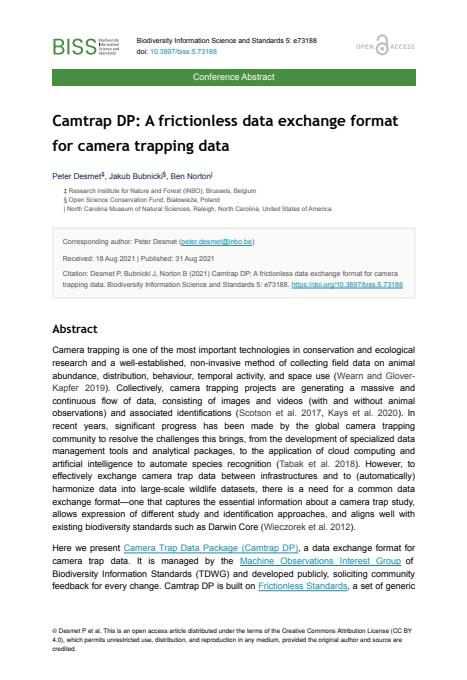Camtrap DP: A frictionless data exchange format for camera trapping data
Details
| Aantal pagina's | 3 |
|---|---|
| Volume | 5 |
| Type | A2: Artikel in een tijdschrift met peer review, dat niet inbegrepen is in A1 |
| Categorie | Onderzoek |
| Tijdschrift | Biodiversity Information Science and Standards |
| Taal | Engels |
Bibtex
@misc{63951d16-3674-4098-8425-e2037992a73a,
title = "Camtrap DP: A frictionless data exchange format for camera trapping data",
abstract = "Camera trapping is one of the most important technologies in conservation and ecological research and a well-established, non-invasive method of collecting field data on animal abundance, distribution, behaviour, temporal activity, and space use (Wearn and Glover-Kapfer 2019). Collectively, camera trapping projects are generating a massive and continuous flow of data, consisting of images and videos (with and without animal observations) and associated identifications (Scotson et al. 2017, Kays et al. 2020). In recent years, significant progress has been made by the global camera trapping community to resolve the challenges this brings, from the development of specialized data management tools and analytical packages, to the application of cloud computing and artificial intelligence to automate species recognition (Tabak et al. 2018). However, to effectively exchange camera trap data between infrastructures and to (automatically) harmonize data into large-scale wildlife datasets, there is a need for a common data exchange format—one that captures the essential information about a camera trap study, allows expression of different study and identification approaches, and aligns well with existing biodiversity standards such as Darwin Core (Wieczorek et al. 2012).Here we present Camera Trap Data Package (Camtrap DP), a data exchange format for camera trap data. It is managed by the Machine Observations Interest Group of Biodiversity Information Standards (TDWG) and developed publicly, soliciting community feedback for every change. Camtrap DP is built on Frictionless Standards, a set of generic specifications to describe and package (tabular) data and metadata. Camtrap DP extends these with specific requirements and constraints for camera trap data. By building on an existing framework, users can employ existing open source software to read and validate Camtrap DP formatted data. Validation especially is useful to automatically check if provided data meets the requirements set forth by Camtrap DP, before analysis or integration.Supported by the major camera trap data management systems e.g. Agouti, TRAPPER, eMammal, and Wildlife Insights, Camtrap DP is reaching its first stable version. The first Camtrap DP dataset was published on Zenodo (Cartuyvels et al. 2021b). This dataset was also published to the Global Biodiversity Information Facility (GBIF) (Cartuyvels et al. 2021a), demonstrating the ability and limitations of transforming the data to the Darwin Core standard.",
author = "Peter Desmet and Jakub Bubnicki and Ben Norton",
year = "2021",
month = aug,
day = "31",
doi = "https://doi.org/10.3897/biss.5.73188",
language = "Nederlands",
publisher = "Instituut voor Natuur- en Bosonderzoek",
address = "België,
type = "Other"
}

